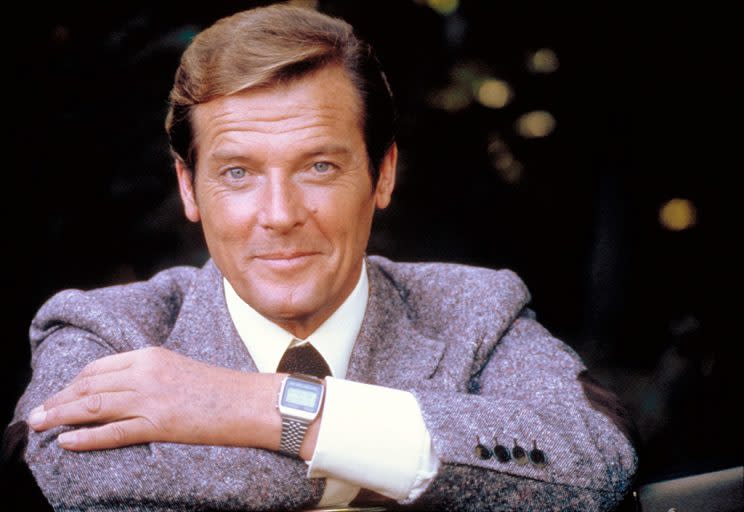Roger Moore Appreciation: The Disarming Charm of His Buoyant Bond

By Carrie Rickey
With typical self-effacing humor, Roger Moore, the longest-serving James Bond in the longest-lived movie franchise, once quipped that he was the “fourth-best Bond.” The English actor, who died of cancer on Tuesday at age 89, indubitably was also the funniest among the six 007s.
Still, many would argue that given Sean Connery’s casual cruelty and Daniel Craig’s clenched intensity, Moore’s disarming charm was superior to both. Moore told it like it was: “Sean played Bond like a killer; I played him as a lover.”
Broad of shoulder and quizzical of brow, Moore understood his limits as a performer and used his likability — principally those dancing blue eyes and that suppressed smile — to great effect.
When he was in a student play at the Royal Academy of Dramatic Arts (RADA) the aspiring actor was checked out and dressed down by Noel Coward, the venerable playwright and actor. “Young man, with your devastating good looks and your disastrous lack of talent, you should take any job ever offered you,” the elder warned. At RADA, Moore, son of South London, learned how to walk with poise, speak proper English, and seduce the audience.
Watch a video about Moore’s death:
Before he became the third screen 007 after Connery and, briefly, George Lazenby, Moore was known to American TV audiences as Beauregard Maverick, James Garner’s well-spoken British cousin, on the popular series Maverick. In 1962, as Connery suited up to play Bond in Dr. No, Moore won the title role of Simon Templar on British television’s The Saint. As the suave thief who steals from the rich and gives to himself, Moore broke the fourth wall, directly addressing the audience, establishing his ease and a viewer rapport that would help save the Bond franchise in a few years. The Saint was a hit on both sides of the Atlantic and around the world.
Moore’s charisma was too large for the small screen. The big man (surely the beefiest of Bonds) needed the big screen for maximum effect. At 46, Moore had to diet in order to get the gig, but he had a no-sweat authority in his debut as the MI-6 agent, with Gloria Hendry, in the Blaxploitation-inflected Live and Let Die (1973). The fans who missed Connery also missed the fact that finally James Bond wasn’t living in the eternal 1960s, but in the here and now.
Watch Moore in a scene with Gloria Hendry in Live and Let Die:
To a large extent Ian Fleming, 007’s creator, based James Bond on his favorite actor, Cary Grant, who possessed effortless humor and grace. (Indeed, the Bond producers initially approached Grant, then 58, to play Bond. The actor demurred.) While Moore didn’t completely have Grant’s grace, he was quite funny, and this climactic moment from The Man With the Golden Gun (1974), a hall-of-mirrors scene where Moore and Christopher Lee stalk each other echoes Grant’s unbuttoned performance in Hitchcock’s To Catch a Thief (1955).
Moore hit his stride in The Spy Who Loves Me (1977), certainly the most entertaining of all Bonds, with one of the greatest opening scenes in film history:
Although the actor, who maintained a home in Switzerland, was an enthusiastic skier, he obviously did not do the stunts in that great sequence. When asked about it, he faux-boasted, “Of course I do my own stunts. I also do my own lying.”
After the outer-space themed Moonraker (1979), the outwit-the-KGB tale For Your Eyes Only (1981), and the saving-NATO suspenser Octopussy (1983), Moore completed his Bond tour of duty with A View to a Kill (1985), in which he outwits a microchip mogul trying to destroy Silicon Valley. Critic Paul Attanasio of the Washington Post complained that Moore was so long in the tooth he was growing tusks. Still, many of us loved the graying, and increasingly elephantine, Moore.
As early as Octopussy, the actor who played Bond as a magnet for bad puns and badder babes began to think that he should hang up his Walther PPK. He said, “There are only so many stunts an aging actor can tackle, and only so many young girls he can kiss without looking like a perverted grandfather.”
After his stint as 007, Moore acted less regularly, devoting much of his time to UNICEF as a goodwill ambassador with his friend Audrey Hepburn and speaking out on how to prevent and/or seek help for HIV/AIDS.
Still, in one important way, Mr. Moore bested his fellow Bonds: His star on the Hollywood Walk of Fame is at 7007 Hollywood Boulevard.
Read more from Yahoo Movies:
